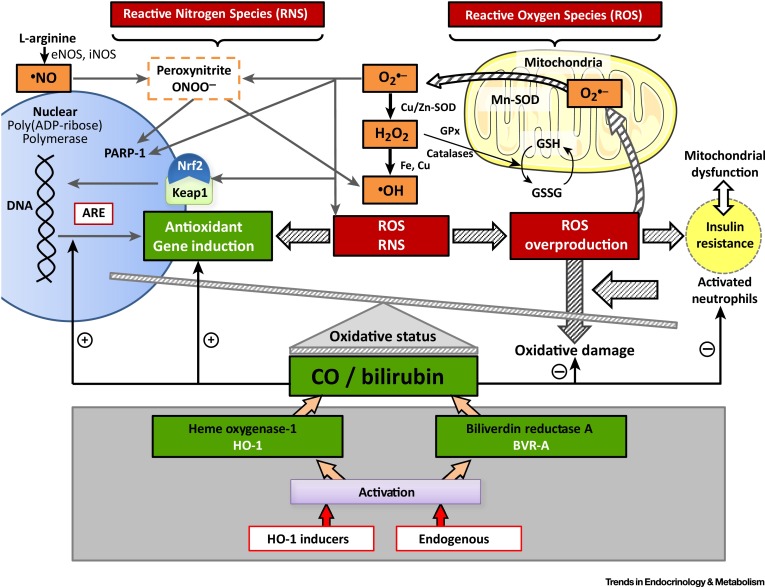当前位置:
X-MOL 学术
›
Trends Endocrin. Met.
›
论文详情
Our official English website, www.x-mol.net, welcomes your feedback! (Note: you will need to create a separate account there.)
Redox Functions of Heme Oxygenase-1 and Biliverdin Reductase in Diabetes
Trends in Endocrinology & Metabolism ( IF 10.9 ) Pub Date : 2018-02-01 , DOI: 10.1016/j.tem.2017.11.005 Luc Rochette , Marianne Zeller , Yves Cottin , Catherine Vergely
Trends in Endocrinology & Metabolism ( IF 10.9 ) Pub Date : 2018-02-01 , DOI: 10.1016/j.tem.2017.11.005 Luc Rochette , Marianne Zeller , Yves Cottin , Catherine Vergely

|
In patients with diabetes, the hyperglycemia-driven excess generation of reactive oxygen species (ROS) induces oxidative stress (OS) in a variety of tissues. OS is closely associated with chronic inflammation and has a key role in the pathogenesis of vascular complications. The enzymes that generate ROS and gasotransmitters are redox regulated and are implicated in cellular signaling. As a result of cellular metabolism, cells produce significant amounts of carbon monoxide (CO), mainly from heme degradation catalyzed by heme oxygenases (HOs). These reactions also generate biliverdin, bilirubin (BR), and iron. The conversion of biliverdin to BR is catalyzed by biliverdin reductase-A (BVR-A). In this review, we focus on the importance of the HO-1/CO system and BVR in the pathophysiology and therapy of inflammation associated with diabetes.
中文翻译:

血红素加氧酶-1和胆绿素还原酶在糖尿病中的氧化还原功能
在糖尿病患者中,高血糖驱动的活性氧 (ROS) 过量生成会在各种组织中诱导氧化应激 (OS)。OS与慢性炎症密切相关,在血管并发症的发病机制中起关键作用。产生 ROS 和气体递质的酶受氧化还原调节,并与细胞信号传导有关。作为细胞代谢的结果,细胞产生大量一氧化碳 (CO),主要来自血红素加氧酶 (HO) 催化的血红素降解。这些反应还会产生胆绿素、胆红素 (BR) 和铁。胆绿素向 BR 的转化由胆绿素还原酶-A (BVR-A) 催化。在这篇综述中,我们关注 HO-1/CO 系统和 BVR 在糖尿病相关炎症的病理生理学和治疗中的重要性。
更新日期:2018-02-01
中文翻译:

血红素加氧酶-1和胆绿素还原酶在糖尿病中的氧化还原功能
在糖尿病患者中,高血糖驱动的活性氧 (ROS) 过量生成会在各种组织中诱导氧化应激 (OS)。OS与慢性炎症密切相关,在血管并发症的发病机制中起关键作用。产生 ROS 和气体递质的酶受氧化还原调节,并与细胞信号传导有关。作为细胞代谢的结果,细胞产生大量一氧化碳 (CO),主要来自血红素加氧酶 (HO) 催化的血红素降解。这些反应还会产生胆绿素、胆红素 (BR) 和铁。胆绿素向 BR 的转化由胆绿素还原酶-A (BVR-A) 催化。在这篇综述中,我们关注 HO-1/CO 系统和 BVR 在糖尿病相关炎症的病理生理学和治疗中的重要性。



























 京公网安备 11010802027423号
京公网安备 11010802027423号